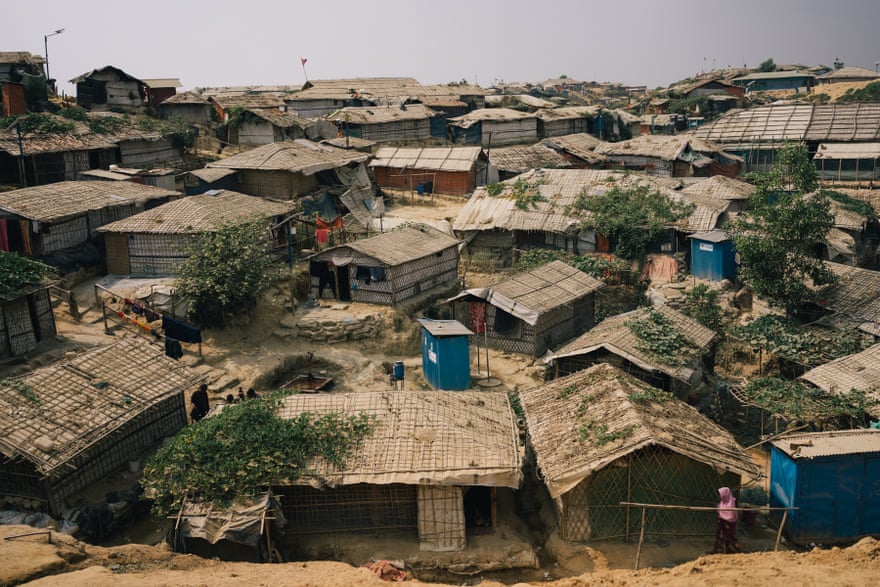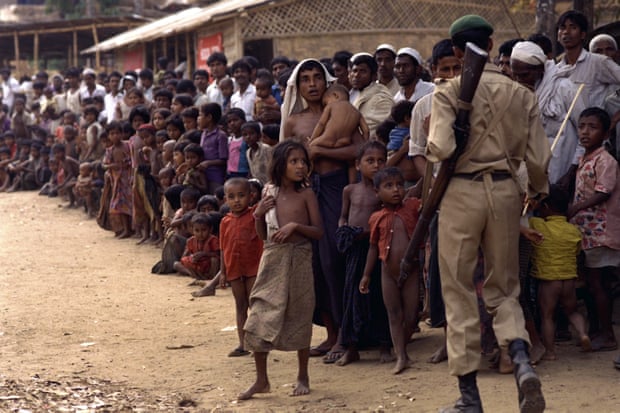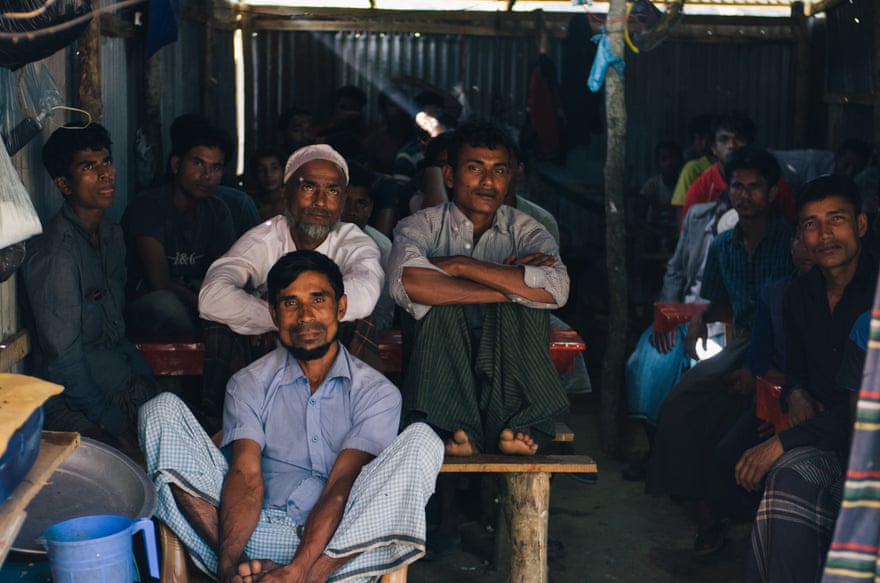Yon the 31 years since Anuara Begum’s family moved into their bamboo shelter in the Nayapara refugee camp, the only improvement they could make was replacing its tarpaulin roof with tin sheeting – less flimsy but hammer-loud when the rains come.
Running from Myanmar’s military, their new home was built to be temporary, and so it proved when it took just 30 minutes for a fire last year to incinerate the metal and bamboo structures of a whole block of the camp.
Fires in the camp have become commonplace in the five years since 700,000 Rohingya fled to Bangladesh, the August 2017 wave joining the approximately 300,000 already there from previous security crackdowns by the Myanmar military.
The conditions those refugees now endure – living in fragile shelters, banned from education, work and travel – have been faced by several generations, who have run for decades from violence and discrimination at the hands of the Myanmar government.
Begum, 23, was born in Bangladesh without any prospect of a safe return to the Myanmar she has never seen.
“We have no peace of mind. The camp is like an open prison for us. Most people suffer with depression and trauma,” she says. “Since I was born, I have faced constant hardship. I have spent my entire life as a refugee, since 1999, and still I can’t find peace.
“I cry when I see a fire. My family can’t sleep properly through the night because of our fear after the fire. My neighbors are constantly scared.”
Rohingya people and aid workers say the refugees who arrived five years ago have been abandoned to the same fate as those before them, accusing the humanitarian agencies of decades of failure to ensure basic rights or to secure a safe return.
One senior aid worker for an international NGO said the UN had consistently failed to challenge the Bangladeshi government over restrictive policies such as the demand that all homes be temporary, its restrictions on education and movement and the relocation of tens of thousands of people to Bhasan Char , an island camp vulnerable to extreme weather.
“Basic shelter standards have not been met, and every year the camp burns down,” he said, asking for anonymity.
“They often blame climate change for this, which is, frankly, bollocks. The fault for those fires is on the UNHCR [UN refugee agency] and IOM [International Organization for Migration]. And they should be held accountable. Where the government has put punitive measures in place, they’ve never been challenged.”

He said the Rohingya posed no significant security threat in Bangladesh, which should ensure more humane conditions.
“It has been a failure and, on the five-year mark, the UN has to be close to saying that it’s failed. They won’t – they’ll say we did our best, and look at all of the things we’ve done. But they’ve essentially created a prison camp in Cox’s Bazar … it’s insane when you think about it.”
Another frontline worker said humanitarian agencies are too concerned about maintaining good relationships with the government so they can continue operating in Bangladesh. “They’re very much reliant on those good relationships with the government and it was my impression that they value those relationships and development programs more than the rights of Rohingya, who were not allowed to leave, to work or receive education,” he said .
At least 7,000 Rohingya were killed in Myanmar’s Rakhine state over several weeks of “clearance operations” by the military, which began on 25 August 2017. Described as “a textbook example of ethnic cleansing” by the UN, the attacks were ostensibly to remove the fringe Rohingya armed group Arakan Rohingya Salvation Army, but targeted civilians instead. The military, and ethnic Rakhine villagers, used killing, arson and rape to drive hundreds of thousands of people to Bangladesh. The UN called it genocide.
Such violence is not new. It was employed by the military in 1978 and 1991, creating similar but smaller refugee crises. Both times, Bangladesh carried out repatriation campaigns to force people back, with apparently little international resistance.
A report, prepared in 2010 but never published, about the UNHCR’s role in the camps and during the repatriations, said that in 1978 and during the 1990s the agency “departed the furthest from its protection mandate and principles in any of its operations worldwide”.
According to that report, seen by the Guardian, the agency cooperated with the government in repatriation efforts during the 1990s, despite concerns about lack of consent, intimidation and, on one occasion, a group of Rohingya being forced at gunpoint to board boats.

A researcher who produced a separate report for the US Congress at the time said that, when invited by UNHCR to witness a repatriation, they were shocked to see Rohingya burst into tears when told they were being returned to Myanmar.
The UN report also noted that Rohingya faced the same violence and controls when they were returned to Myanmar. Some found their home villages had been taken over as military bases. They faced increased taxes and more restrictions on their movements. Many made the journey back to Bangladesh.
The report was particularly damning on the lack of involvement the Rohingya played in decision-making. It quoted a senior official who said in a meeting: “The Rohingya are primitive people. At the end of the day, they will go where they are told to go.”
Rohingya people have repeatedly complained at not being consulted in the repatriation process, including when the UN signed a memorandum of understanding with Myanmar which did not address their main demand – the restoration of citizenship rights stripped away in 1982.

UNHCR spokesperson Regina de la Portilla said it will ensure any future repatriation is safe and that informed consent is obtained, but that the conditions in Myanmar are not currently suitable for a return. “It’s clear that, this time around, the return needs to be voluntary, safe and sustainable, and that it can only happen if the basic rights and the human rights of the Rohingya in Myanmar are ensured,” she said.
“This implies that they are granted documentation, have had services, have freedom of movement, and their safety is ensured.”
A lack of opportunity in the camps has helped feed a trafficking network that has seen tens of thousands of Rohingya trafficked from Bangladesh and Myanmar to Malaysia. In 2015, the Thai government discovered mass graves at one of the jungle camps where refugees had been held captive.
The trafficking network seemed dormant for several years after that but is now active again, with reports of boats arriving into southeast Asia. Last week, the Indonesian navy had to retrieve a sinking boat carrying more than 100 people.
Rohingya complain that insecurity has spiraled in the camps, fueled by armed gangs vying for dominance. Last year, the most prominent Rohingya civil society leader, Mohib Ullah, was assassinated in his office. Two other leaders were shot dead in the camps last week.
Speaking at Nayapara refugee camp, Anuara Begum says gang members have threatened to abduct her if she continues to work with NGOs and advocate for girls’ education. “They said I’m a bad influence for the community. The miscreants threatened to kidnap me if I go outside any more,” she says.
“I fear them now, and can only secretly go outside. I already feel dead inside.”

All Bangladesh’s attempts to begin repatriations have failed, with no refugees signing up willingly to return. Last year’s military coup in Myanmar means the country is no safer for the Rohingya than in 2017.
Progress towards justice has also been slow. A genocide case against Myanmar, taken by the Gambia to the UN’s International Courts of Justice, moved beyond the preliminary stage in a recent ruling, but the investigation by the international criminal court into forced deportations by the military has been slower.
Evidence gathered by the Commission for International Justice and Accountability, and submitted to the ICC investigation, indicated that there was evidence the Myanmar military had for years planned operations to expel the Rohingya.
De la Portilla said the UNCHR has tried to improve conditions within the temporary response framework set out by the government, with better sanitary systems, the ability to respond to fires, and gradually rolling out limited secondary education. But funding has become a major barrier, especially when global prices have soared for key items like gas, which prevents refugees from having to cut firewood.
Khin Maung leads the camp-based Rohingya Youth Association. He says UN rights chief Michelle Bachelet told the refugees at a meeting last week that conditions are not right for repatriation. “The military regime has no plan to take back Rohingya, it just shows fake willingness on social media to get legitimacy from the international community and Bangladesh government,” he says.
“[Meanwhile], the conditions in the camps are not good. Nothing is changing at all and violence is increasing.
“The Rohingya community must start political activism for self-determination. We have the right to struggle for our ethnic rights like other minority communities in their areas. Why not for our community? The solution is in our hands.”
Sign up for a different view with our Global Dispatch newsletter – a roundup of our top stories from around the world, recommended reads, and thoughts from our team on key development and human rights issues, delivered to your inbox every two weeks:
Sign up for Global Dispatch – please check your spam folder for the confirmation email
www.theguardian.com
George is Digismak’s reported cum editor with 13 years of experience in Journalism